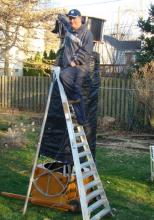Feed aggregator
Our closest neighboring galaxy may be being torn apart
A team has revealed new insights into the motion of massive stars in the Small Magellanic Cloud (SMC), a small galaxy neighboring the Milky Way. Their findings suggest that the gravitational pull of the Large Magellanic Cloud (LMC), the SMC's larger companion, may be tearing the smaller one apart. This discovery reveals a new pattern in the motion of these stars that could transform our understanding of galaxy evolution and interactions.
'Hidden galaxies': Key to unlocking some of universe's secrets
Astronomers have peered back in time to find what looks like a population of 'hidden' galaxies that could hold the key to unlocking some of the universe's secrets. If their existence is confirmed it would 'effectively break current models of galaxy numbers and evolution'. The possible galaxies may also provide the missing piece of the puzzle for the energy generation in the universe in infrared light. That's because their combined light would be enough to top-up the energy budget of the universe to the maximum we observe, effectively accounting for all remaining energy emission at these long wavelengths.
Scientists source solar emissions with largest-ever concentration of rare helium isotope
The NASA/ESA Solar Orbiter recently recorded the highest-ever concentration of a rare helium isotope (3He) emitted from the Sun. A Southwest Research Institute-led team of scientists sought the source of this unusual occurrence to better understand the mechanisms that drive solar energetic particles (SEPs) that permeate our solar system. SEPs are high-energy, accelerated particles including protons, electrons and heavy ions associated with solar events like flares and coronal mass ejections.
Do 'completely dark' dark matter halos exist?
Every galaxy is thought to form at the center of a dark matter halo. Stars are formed when gravity within dark matter halos draws in gas, but astrophysicists don't know whether star-free dark matter halos exist. An Diego astrophysicist has calculated the mass below which halos fail to form.
Astronomers discover doomed pair of spiralling stars on our cosmic doorstep
Astronomers have discovered an extremely rare, high mass, compact binary star system only ~150 light years away. These two stars are on a collision course to explode as a type 1a supernova, appearing 10 times brighter than the moon.
Solar wave squeezed Jupiter's magnetic shield to unleash heat
A solar wind event from 2017 that hit Jupiter and compressed its magnetosphere created a hot region spanning half Jupiter's circumference.
Solar cells made of moon dust could power future space exploration
The same dirt that clings to astronauts' boots may one day keep their lights on. Researchers created solar cells made out of simulated Moon dust. The cells convert sunlight into energy efficiently, withstand radiation damage, and mitigate the need for transporting heavy materials into space, offering a potential solution to one of space exploration's biggest challenges: reliable energy sources.
Galaxies die earlier than expected
For a long time, scientists thought that only actively star-forming galaxies should be observed in the very early Universe. The James Webb space telescope now reveals that galaxies stopped forming stars earlier than expected. A recent discovery deepens the tension between theoretical models of cosmic evolution and actual observations. Among hundreds of spectra obtained with the Webb program RUBIES, the team has found a record-breaking galaxy that had already stopped forming stars during an epoch where galaxies are normally growing very rapidly.
Insight from one of Milky Way's most extreme environments
In new images, scientists have gotten the closest look yet at Sagittarius C -- a 'stellar nursery' where clouds of gas and dust have collapsed to form thousands of new stars.
Sound frequencies of stars sing of our galaxy's past and future
Researchers interrogated the 'sounds' of a cluster of stars within the Milky Way, uncovering a new technique for astrophysicists to probe the universe and learn more about its evolution.











